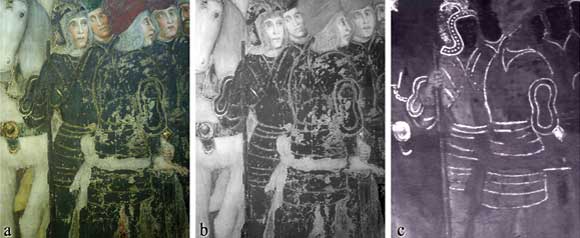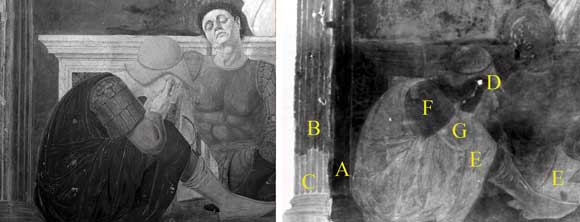
Reflected light helps preserve frescoes
L’AQUILA, VERONA and FLORENCE, Italy – A new imaging technique that works somewhat like thermography in reverse uses reflected mid-infrared light to further refine the restoration of old masters.
The powerful yet safe imaging tool for artwork diagnostics, called thermal quasi-reflectography (TQR), was developed by the University of L’Aquila, the University of Verona and the National Institute of Optics in Florence. It captures features not otherwise detectable with the naked eye or current imaging techniques.
Unlike thermography, which detects subtle temperature differences resulting from the pigmentation on the surface of
paintings, TQR does not detect heat emitted from paintings, but rather tries to minimize it. The system shines a faint mid-IR light source onto the surface and records the light that is reflected back to a camera.
Paintings typically emit more energy in the longer infrared wavelengths than in the mid-IR at normal room temperatures. To take advantage of this weak emission, the scientists applied the basic tools of thermography and ran them in reverse. They used underpowered halogen lamps as the mid-IR source, taking special care to prevent the lamp from heating the painting’s surface and to exclude all other potential sources of that type of radiation.
The mid-IR offers advantages over other wavelengths in differentiating material on a painted surface. It has better contrast and produces sharper images than studies in the far-IR and, using wavelengths less than approximately 2 µm, can detect features not seen in the near-IR.

Part of the fresco by the Zavattari brothers in the Chapel of Theodelinda. The artworks, executed between 1440 and 1446, are extremely rich and complex, featuring various fresco techniques, gold and silver decorations, and reliefs. Color photography (a) and imaging in the near-IR (b), compared with the thermal quasi-reflectography image (c); thermal quasi-reflectography (TQR) captures details not detected by other techniques. Images courtesy of Optics Express.
To assess its TQR system, the team first tested a small section of the Zavattari frescoes in the Chapel of Theodelinda in the Monza Cathedral, near Milan. It revealed details that were missed by earlier optical and near-IR studies.
“Our system easily identified old restorations in which missed gold decorations were simply repainted,” said Claudia Daffara of the University of Verona and lead author of the study. “The TQR system was also much better at visualizing armor on some of the subjects in the fresco.”
The mid-IR system also was used to study Piero della Francesca’s painting The Resurrection. It identified interesting features, such as highly reflective retouches from previous restorations, all while operating during normal museum hours without interruption. An area around a soldier’s sword painted using two different fresco techniques offered up the most surprising discovery, a subtle distinction not detected by near-IR photography.

The Resurrection by Piero della Francesca (detail): near-IR image (left) and TQR image (right). A, original area; B and C, painted integration; D, restoration plaster; E, green earth pigment; F and G, pigments with similar behavior in the visible and different reflectivity in mid-wave IR.
“For mural paintings, the use of the mid-infrared regions reveals crucial details,” Daffara said. “This makes TQR a promising tool for the investigation of these artworks.”
The scientists now want to determine whether the system can provide infrared spectra of the surface of paintings, which would identify which types of pigments were used and how best to protect and restore the artwork, said Dario Ambrosini of the University of L’Aquila.
Other applications for the technique include differentiating surface materials, Ambrosini said.
The research was published in Optics Express.
Published: September 2012